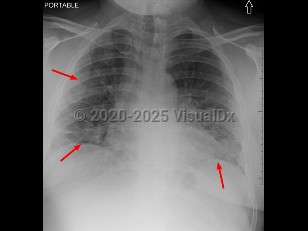Coronavirus disease 2019 (COVID-19), previously known as 2019 novel coronavirus (2019-nCoV), is caused by severe acute respiratory syndrome coronavirus 2 (SARS-CoV-2).
Clinical features:
Clinical features primarily include fever and upper respiratory tract symptoms with rhinorrhea, congestion, and pharyngitis that can progress to include symptoms of lower respiratory tract illness (eg, cough, shortness of breath), although many patients also report associated gastrointestinal complaints (nausea, vomiting). Reported cases have ranged from asymptomatic to severe; the case fatality rate varies worldwide, ranging from 0.1%-4.9% based on data compiled by Johns Hopkins. Clinical presentation can vary significantly, particularly with respect to vaccination and boosting status and time from last COVID infection.
Illness can range from mild to critical:
- Mild to moderate (mild symptoms up to mild pneumonia)
- Severe (dyspnea, hypoxia, or > 50% lung involvement on imaging)
- Critical (respiratory failure, shock, or multiorgan system dysfunction)
SARS-CoV-2 spreads from person to person easily. The incubation period is estimated to be between 2 and 14 days after exposure, with an estimated median incubation period of about 3-5 days. This incubation period appears to vary slightly with respect to different variants.
- The virus is transmitted primarily via infectious secretions (respiratory droplets and sputum) between individuals in close contact (within 6 feet).
- Airborne transmission can occur, particularly within enclosed spaces (even those with adequate ventilation) or under circumstances where the infectious individual is breathing heavily, such as while exercising or singing.
- Transmission of SARS-CoV-2 from asymptomatic or presymptomatic persons can occur.
- It is not determined whether the virus can be transmitted by blood, vomit, urine, breast milk, or semen.
Multiple variants of the virus have circulated globally, including in the United States, and new variants are expected to occur. Omicron continues to be the dominant variant in the United States. Subvariants may be less sensitive to neutralizing antibodies from prior COVID-19 vaccines and prior COVID infections and cause higher rates of reinfection.
Reinfection:
Individuals previously diagnosed with COVID-19 may become infected again due to waning immunity from prior infection and/or waning vaccine effectiveness that occurs over time.
Breakthrough infection:
Breakthrough infections may occur in individuals who are up to date with COVID-19 vaccinations. However, vaccinated individuals are much less likely to experience severe symptoms than unvaccinated people.
Infection prevention and control in health care settings:
The CDC has provided updated guidance on infection prevention and control to reduce facility risk, isolate symptomatic patients as soon as possible, and protect health care personnel.
About COVID-19
Coronaviruses are a family of viruses, some of which cause infection in humans and in animals such as camels, cats, and bats. When animal coronaviruses evolve, on rare occasions they can become infectious to and spread between humans (a zoonotic infection) as has occurred with Middle East respiratory syndrome (MERS) and SARS. This animal-to-human spread has been postulated to have occurred with SARS-CoV-2 with subsequent person-to-person transmission.
Related topics: multisystem inflammatory syndrome in adults, multisystem inflammatory syndrome in children, post-COVID conditions, skin and oral mucosal manifestations of COVID-19


